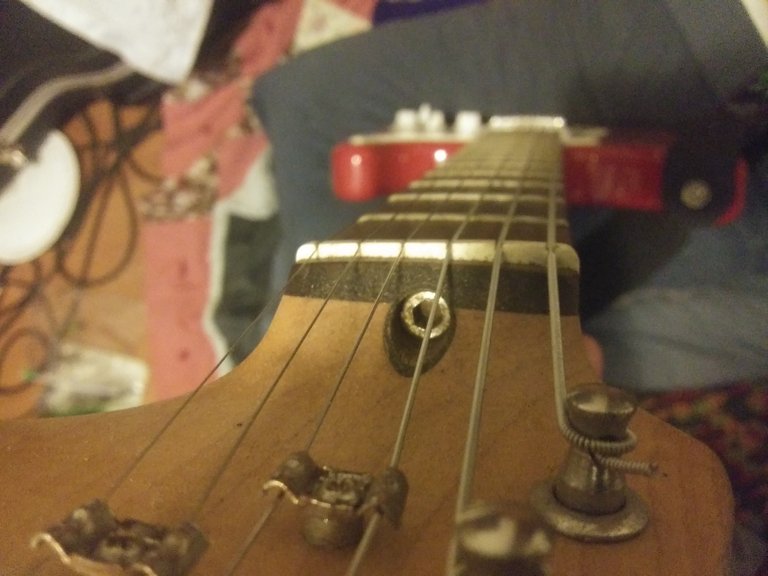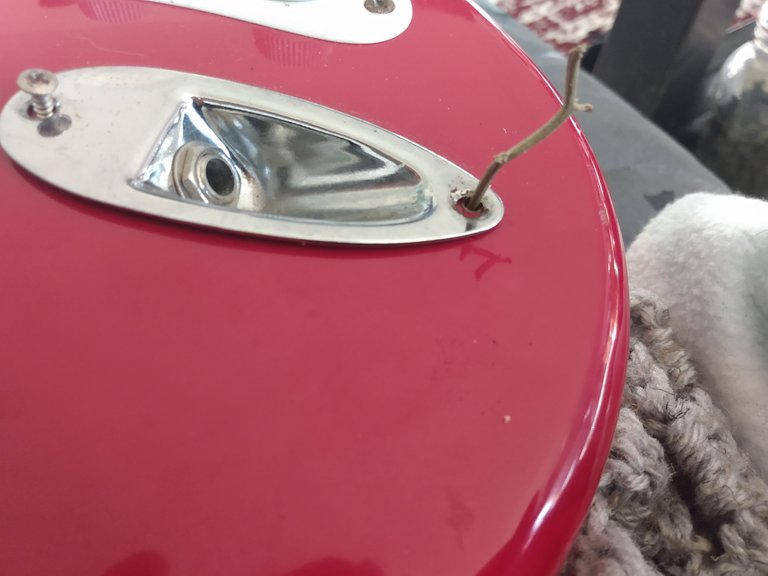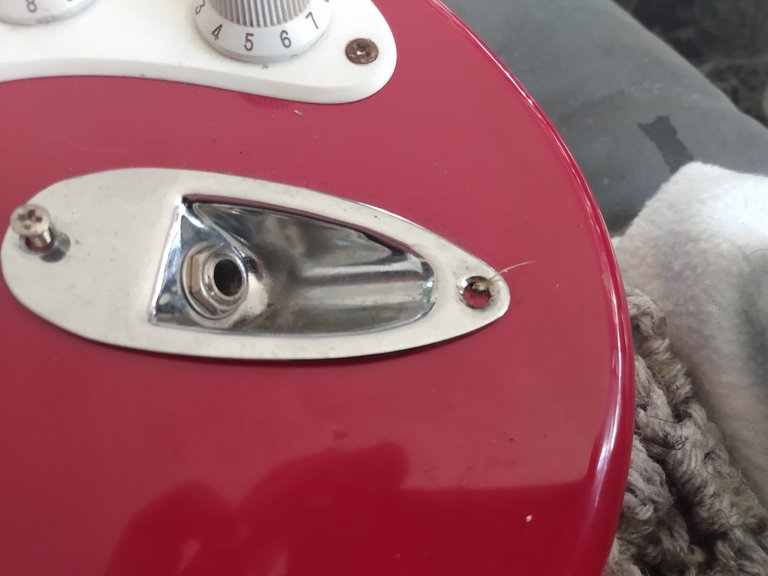For today's post, I'll be walking you through the basic adjustments on a typical Strat style guitar. I'll also share a tip for fixing stripped screw holes, a common problem on cheap electric guitars.
The first step for me is always to see if the neck has a truss rod, which is a mechanism built into the neck that allows you to adjust the curve of the neck and fretboard. If your guitar has one, there will be a way to adjust it, usually with a hex head bolt at just above the nut, as seen below. Sometimes these will have a small cover over them, and I've seen a few guitars, mostly acoustic, that have the adjuster at the lower end of the neck. If you've never done a truss rod adjustment before, I highly suggest finding a more detailed guide to read before trying it out on your favorite guitar... you can damage the neck with this. Generally, tightening the adjuster will pull up the ends of the fretboard, loosening it will push the ends down (and raise the middle). Usually, you will be loosening (not really, but you turn it counter-clockwise) the adjuster to flatten out a bend in the neck that has occurred over time. Perfect adjustment can vary from guitar to guitar, but generally when it's adjusted properly, if you hold down a string at the first and last frets, there should be just enough room to slip a sheet of paper under the string in the middle of the neck.

Once my neck has the right curve, I move down to the bridge. Some guitars will have no bridge adjustments to make, especially acoustic guitars. On this one, each string has its own (I think they're called...) saddle. The distance to the nut can be adjusted by the phillips head screws seen at the very bottom of the picture, and the height can be adjusted by two inset hex screws at the upper end of each one. I like a light touch on my guitar, so I lower each one as low as I can without having any 'buzz' on the string. If you don't know what 'buzz' is, you will. Adjusting the distance can change how much tension you need on the string to put it in tune, but I usally just use this adjustment to align all the saddles in a way that's comfortable for my hand. The way I lower them, the height adjustment screws end up digging into my palm a little, so if I have a guitar set up just the way I love it, I'll file them down flush with the saddle.

The pickups will usually be my final adjustment. Most will have an adjustment screw on either side that allows you to raise or lower the pickup, as shown below. I like to get mine as close to the strings as possible without touching them, which will give the strongest signal to your gear. I've had a couple of guitars where I would lower one of the pickups, to get better volume balance when switching between different ones. I'll tell you how to mess with your stuff, I'll leave the decisions about HOW to mess with it up to you! 😂

This dusty old war horse was in pretty good shape for its age. It did have a loose screw at the plug, though, which was causing some annoying noises when plugged in and turned on. An old-timer's tip for fixing stripped screw holes is to just stick another piece of wood in the hole. For this, I had a piece of weed stem handy. Usually, I'll use a toothpick or a bamboo skewer. The bamboo skewers work great for stripped holes in your door hinges.

I like to break the insert off as close as I can to flush before putting the screw in, but some people insist it will hold better if you let the pressure from the screw head cause it to break. I don't know if it actually works better, I know that doing it my way works well enough, and leaves a cleaner finish.

And just like that, this one was ready to play! It only took two years for me to get around to it. 😏 I hadn't been playing too much since losing almost all my gear in a nasty separation, but now that I'm getting a little studio room put back together, I've been feeling that itch. Maybe by this winter I'll have a little music to post. (Imagine a 'fingers crossed' emoji here, I'm not going to spend 5 minutes looking for it :)

Do you have a favorite guitar you've brought back to life, or even just a favorite instrument? Tell me all about it! I haven't talked much music shop on this platform yet, but I'm always eager to have that conversation! Give a follow for more miscellaneous repair tips, give a vote if you learned something, or just liked the soothing song of my sentences. If not, no love lost, I'll still be wishing you well and seeing you around!
Oh and one note!
You said you like to raise your pickups close to your strings.
I too like the way that sounds, but it kills your sustain!
I spent a lot of time adjusting mine to try to find a nice balance.
Thanks for that advice, you just taught me something new!
I had an old ibanez from my youth which was cutting in and out sound wise. I always meant to have a poke about the input jack and see if anything was loose but never found the time. At least not til lockdown when I was staring at it and realised I did have the time. As soon as I opened it I saw a total basic loose wire. Quick solder and boom, bobs yer uncle it was fixed. Its great when yo ucan fix an old favourite!
Nice! My very first guitar repair was the same thing, on my very first electric guitar, which was an even cheaper model of the one in the pictures.
I have an old BC Rich in the basement that was already there when I bought the house some 15 years ago. Someone had gutted the wires and started stripping the paint, and there's a crack between the neck and the headpiece. Still, all the original hardware is there, and I'm thinking it's finally time to get to work on that monster!
That would certainly be an interesting repair/rebuild...
My only guitar is a Fender Squire Stratocaster. The tuners on it are fairly crappy, and don't have screws holding them on the head stock. Recently, the pin that keeps the tuner from turning broke off, leaving the pin in the wood. I need to replace it, but regular Fender tuners don't fit the hole properly. I'm going to replace it with a tuner that's held in with a screw, but I need a ferrule that will fit the hole through the headstock properly. I might have to make one if I can't find one.
Okay, I have a few thoughts on this.
First, where the pin broke off, can the stub end of that's left in your tuner just be removed and replaced? These pins are usually just pushed in through a hole, and can be pushed back out with small pin punch. If you can get the stub out, you could just replace the pin with a small screw. If you're having a hard time getting the broken piece of pin out the wood, try first heating the pin by holding the tip of a soldering iron against it for a few seconds, then try gripping the end of the pin with small wire cutters, or flat-nosed lineman's pliers if there is enough sticking up.
Another thought is that you may be able to find another 'parts' Squier for cheaper than a new tuner. Lots of people have these things gathering dust, especially the Strats. People don't usually post their broken guitars for sale, but if you ask around you might be able to find something for free. The guitar in the post is in fact a Squier Strat that was given to me by someone who aquired it for free as part of a clean up job.
If you've got the money and want a little upgrade, you can buy whole neck assemblies online. Prices can range from $20-$250.
Upgrading the whole set of tuners is also fairly inexpensive, you can get full sets of tuners on eBay for less than $20, nice ones for less than $50.
Don't be afraid to just drill the holes in the headstock a little bigger, either. Even if the hole gets a little sloppy, the tuner post will eventually hit a stop point against the side of the hole and stay in place. Headstock is usually maple, and it can take a LOT of damage without much fear of splitting.
I was thinking about replacing all of the tuners with better quality ones. The ones on my Squire have bodies made of pot metal, they're not all that strong. The body of the tuner is broken as well as the pin that stops it from turning in the hole in the headstock.
This got me thinking about messing with my guitar.
I'm curious what kind of music do you like to play?
I started out on bass in a punk band. Eventually ended up in metalcore/hardcore bands also playing bass. I still have my Ibanez 4 string, but since leaving bands behind I didn't often play bass solo.
Eventually a friend gave me a starter Ibanez acoustic 6 string, and finally I decided to get an electric and amps/pedals.
Ended up getting a Squier Telecaster. I don't know why, but the shape of the Telecaster has always appealed to me over the Stratocaster. Oddly, Teles aren't usually the first choice for metal/heavy music, but I went with one anyways.
I love the way mine sounds especially with the bridge/lipstick(neck) or just the lipstick selected. It's a...bubbly/warm/bright sound.
I've never done a truss rod adjustment, but I'm wondering now if I might need to try that. First fix I had to do on the Tele was with jack which is a typical point of failure on them. Unlike with Strats with the top/front of body plug, they have the "bell" style in the bottom corner. Luckily it was easily fixed with tigtening up.
One thing I can't figure out about my Tele is how uncomfortable it is to play the lowest frets. Like you have to contort your wrist really hard to make bar/power chords on those low notes. I've tried to figure out what about the guitar makes this more taxing. My ex girlfriend had a Les Paul Modern II, and it made my Tele feel alien. It was so comfortable and easy to play those notes. Compared them, and the distances weren't that much different. But obviously something is very different about them.
Needless to say, next axe I buy is going to be a Epiphone Les Paul Modern II :)
A Tele would actually be my first choice, but I've never actually owned one. Les Paul style guitars have very different playability because they're actually designed slightly different from most (I've been told this, I've never worked on a Les Paul). Where most guitars have the neck set flush or angled slightly up with respect to the body, LPs have the neck angled slightly down, with a raised bridge.
The input jack is a common failure on pretty much EVERY guitar. My Ovation (cheapest one they sell) is the only guitar I've owned that I've never had to repair the jack. Truss rod adjustment can definitely help get the playability there on your Tele, in my experience the entire Squier series needs (very slight) adjustment every few years.
Some more tips if you're going to give it a try: Pull back slightly on the headstock (bending the neck to tighten the strings) when making your adjustment, if you don't remove or loosen the strings. This will help remove tension on the inner mechanism, and make the adjuster easier to turn.I like to make adjustments with the guitar in tune, so you can easily check it with proper string tension. If the adjuster is stuck, work it back and forth until it turns easily. If the inner mechanism is corroded, this will loosen that mechanism up so you're less likely to damage it.
If you have all day to REALLY fine tune truss and bridge adjustment, maybe file a few frets that buzz too much, most Squiers can have feather-light playability at any fret, even with heavy guage strings. The problem with the Squiers is that they won't stay that way as long as the full price Fenders.
Yeah I'd like to take the time to actually learn how to work on it rather than take it to a luthier. I've always been the kind of person to work on my own stuff. I don't have any frets that are too bad with buzzing, but I could just be used to it too. The idea of filing them down scares me, but I have the tools to do it.
And yes, the Squiers vs. Mexican/American Fenders is all about durability. Any touring musician will tell you that a Squier simply won't hold up while steadily touring.
I tend to buy more affordable guitars because I just don't play enough to justify the $1000 price tag, but if I found the right guitar maybe.
Like I said next purchase will probably be a Epiphone Les Paul like my ex girlfriend had, but I also really want a double humbucker Telecaster(I think it's called the 1976 deluxe). There' also a Telecaster that has the Stratocaster style head-stock and at least one humbucker. I also really like the Jazzmaster, Jag-Stang, Mustang, and Jaguar Fenders, and they're all available in Squier releases now too :) I love the shape of those.
If I ever get another bass it'll probably be a Fender too.
And yeah, Les Paul's necks are set into a single piece of wood that widens out to become the body. Versus Fender's bolt-on necks. Fenders were designed as the first practical and efficient guitar to manufacture. With Gibsons a larger piece of wood was needed for each body, and a lot of it was going to be wasted. Fun fact: the original Gibsons used a wood for the body or neck(can't remember for sure) that's no longer available because the tree is a protected species now.
Congratulations @paradoxtma! You have completed the following achievement on the Hive blockchain and have been rewarded with new badge(s) :
Your next target is to reach 10000 upvotes.
Your next target is to reach 700 comments.
You can view your badges on your board and compare yourself to others in the Ranking
If you no longer want to receive notifications, reply to this comment with the word
STOPCheck out the last post from @hivebuzz:
Support the HiveBuzz project. Vote for our proposal!